| Article ID | Journal | Published Year | Pages | File Type |
|---|---|---|---|---|
| 1583183 | Materials Science and Engineering: A | 2008 | 6 Pages |
Semisolid metal (SSM) processing has become an important industry forming process. Now, the traditional casting or forging alloys cannot show all advantages of semisolid metal processing. Especially, the magnesium alloys currently used in SSM processing are restricted to a few commercial alloys such as AZ91, AM50 and AM60. Therefore, in order to vary semisolid alloys, a new Mg–10Al–4Zn alloy is designed on the basis of conventional AZ91D alloys in this paper. The microstructure evolution and rheological parameter of semisolid Mg–10Al–4Zn alloy was investigated. The microstructure of casting consists of α-Mg and β-Mg17Al12. After compressed by a ratio of 40% in height at the temperature of 210 °C, the microstructure of Mg–10Al–4Zn alloy changed from developed dendrites to near-equiaxed grains, and all the dendrites oriented in the same orientation. Whereafter, fine recrystallization grains were formed by the release of the stored fault energy induced by deformation at the elevated temperature. The Mg17Al12 phase containing zincum firstly melted between boundaries of the primary grains and then penetrated into recrystallization grain boundaries, which resulted in the separation of the fine primary grains suspending in liquid phase. The partially melting was discussed through analyzing the phase transformations. In addition, the research on rheological parameters such as solid fraction, the particle size, the spherical degree, and the distribution of liquid phase showed that the Mg–10Al–4Zn alloy had a good semisolid performance.
